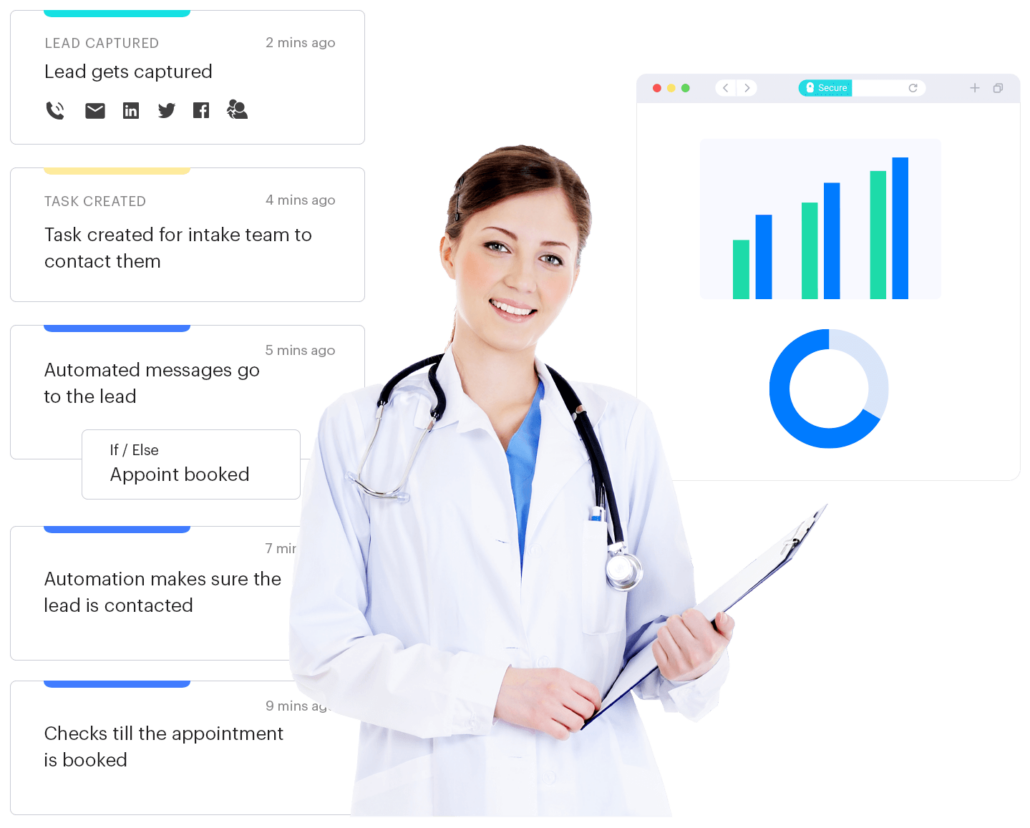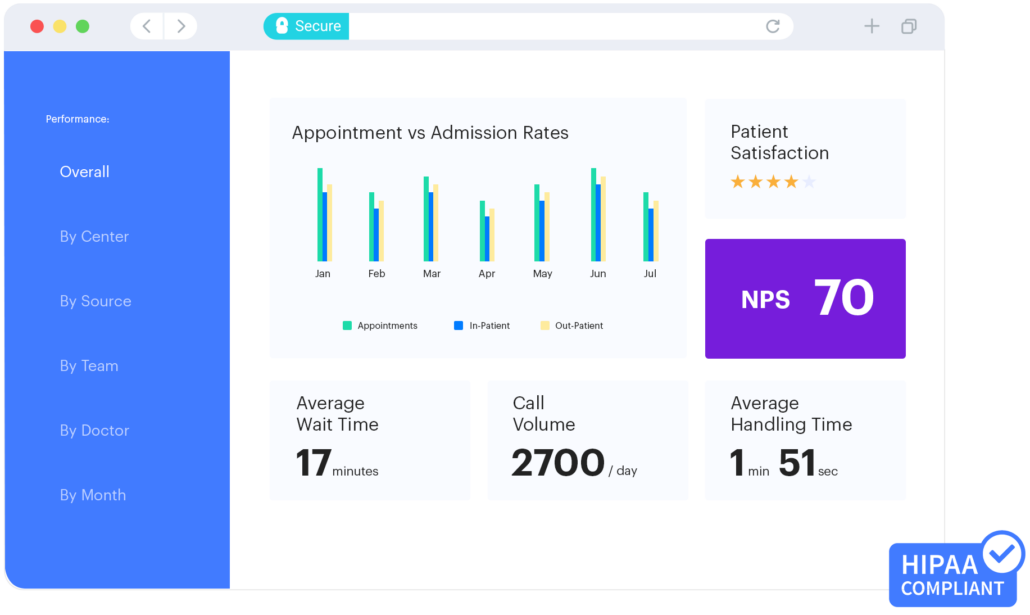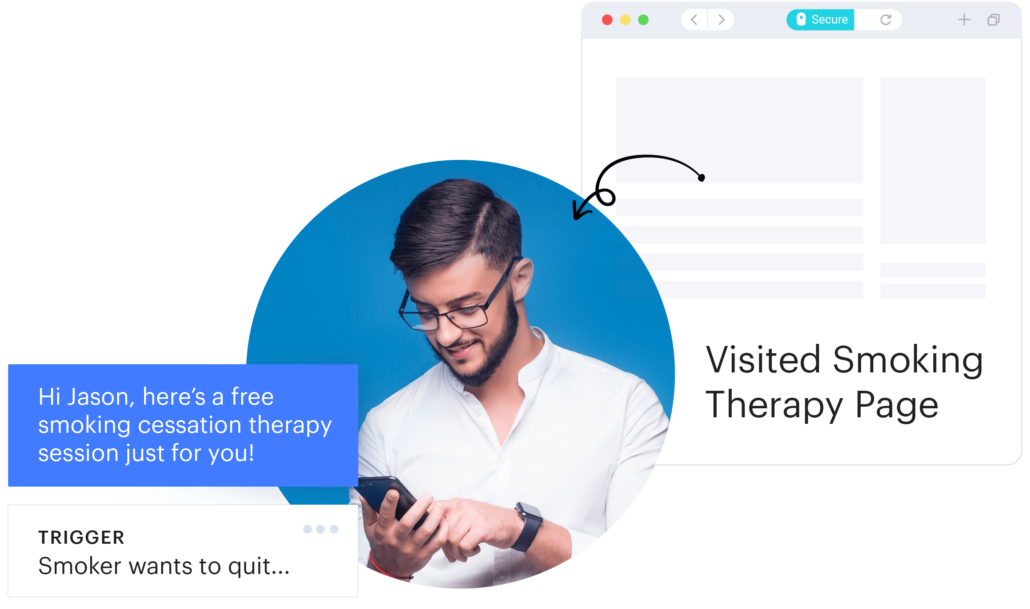- Home
- Learn
- Healthcare
- Patient Management Software (PMS): Features, Benefits, & Tools
HEALTHCARE
Patient Management Software (PMS): Features, Benefits, & Tools
Contents
What’s the first thing that comes to mind when you provide care for a patient?
Doctors agree that giving immediate and effective treatment is the #1 priority. Even better, if it is something you can prevent and treat in its early stages.
But carrying out these processes manually is exhausting. Especially when you’re drowning in paperwork and reports.
Healthcare organizations are rapidly adopting technology to manage patient-related activities more effectively. A patient management software is one such tool that you need to improve your healthcare practice’s efficiency, and it is a crucial component of comprehensive practice management systems.
Healthcare organizations are rapidly adopting technology to manage patient-related activities more effectively. A patient management software is one such tool that you need to improve your healthcare practice’s efficiency.
But before we get into the benefits or features, let’s first understand what patient management software is.
A Patient Management Software or PMS is a tool to manage administrative tasks and store patient records. Patient management isn’t limited to scheduling an appointment, evaluation, treatment, and discharge. Healthcare professionals also need to build meaningful relationships with patients to facilitate care delivery and an excellent patient experience.
Essentially, patient management takes up a lot of time but a patient management system can automate the following functions to allow your doctors to spend more time with their patients instead:
Patient management software also allows you to enable patient portals for healthcare staff to access test results, prescriptions, medical history, and more.
These are just some of several features you can use with patient management software. But there are a lot of other challenges that healthcare workers face. Let’s look at how patient management software can solve them.
Patient management software offers numerous benefits that transform healthcare delivery. It enhances patient satisfaction by automating routine tasks, allowing providers to focus more on care and less on paperwork. This creates a smoother workflow and a better patient experience.
The software also boosts efficiency by centralizing patient data for quick access. It minimizes time spent searching for records, simplifies appointment management, reduces no-shows, and ensures timely care.
Additionally, it enables tracking and analysis of patient data, providing insights into behavior, outcomes, and practice performance. These insights help improve engagement and care quality.
Overall, patient management software streamlines operations, improves satisfaction, and optimizes healthcare practices.
Challenges Faced by Healthcare Professionals
Today, patients want advanced and efficient care at short wait times. At the same time, doctors and healthcare professionals want to concentrate on treatment rather than paperwork and reports.
Below are some of the most common challenges they face due to the lack of a PMS:
This is just the tip of the iceberg when it comes to healthcare. In the meantime, patients have higher expectations of doctors and the healthcare sector.
Your prospective patients consult Google before they choose a provider. For instance, 94% of patients read online reviews when selecting a doctor or provider. Therefore, online presence has become necessary, but almost every provider has a website.
The only differentiator is patient satisfaction.
So, what can you do to meet these expectations? Implement a Patient Management System!
As we have seen, administrative tasks take up a lot of time, which could otherwise be spent delivering better care to patients.
Hospitals and private practices aim at reducing operational costs to increase profitability. Let’s look at a few features of patient management software that make it a great aid in this pursuit..ns?
Implement a Patient Management System!
Appointment scheduling is an inescapable aspect of any in-person interaction. Recent research shows that:
The above numbers confirm that online channels for communication are an essential part of your patient management system. Not implementing them can also result in decreased patient acquisition.
A patient management system can ensure that you effectively schedule any future appointments. It can track and record information from various sources. Thus, allowing you to follow up with patients and reduce no-shows. It makes it simple to book appointments for patients as well. Patients can check the doctor’s availability and book an appointment online.

Appointment automation immensely reduce wait times and evenly distribute leads among providers. It also manages patient-to-medical-staff communication to confirm diagnostic and treatment sessions.
Some patient management systems like Healthcare CRM integrate with EHR to access and update patient information. Others collect and process critical patient data for use in the billing software.
Healthcare providers should be able to easily track, store, and access their patients’ medical records.
While both EHR and patient management system can store patient records, they serve different purposes. EHR systems are built to make heath records sharable and accessible across the healthcare ecosystem. Whereas a PMS tool ensures that you have access to all the patient interactions—even if they have consulted multiple departments.
With a PMS software and EHR, you easily get access to patient records, such as:
Before selecting a patient information management system, figure out what you need. For instance, you should be able record, update, and archive critical patient data. It should take place within the system for access during future encounters.
The patient management system keeps track of and optimizes patient contact. It carries out such actions before they even enter the hospital. Electronic intake forms are typically generated by the patient check-in software module.
These forms are for them to fill out ahead of their visit. These processes speed up a patient’s first clinic or hospital appointment while simultaneously cutting down on time spent completing paperwork in person.
Patients will check-in online once they arrive, and the system logs their wait times. The patient’s wait time information provides metrics for performance evaluations.

Patient management software keeps track of:
Patient engagement tools are another great asset to your PMS. Most engagement tools are features within the software.
Hospitals, medical offices, and other institutions need to meet healthcare consumer expectations. Most patients expect medical professionals to provide excellent personalized care. They want their providers to:
Patient engagement tools make it easier to urge patients to take an active role in their care. It promotes the development of a collaborative patient-doctor connection. It eventually helps improve patient satisfaction and experience.
Nobody likes to talk about money in healthcare, yet it’s an unavoidable part of the profession. Billing features in patient management systems help to relieve the strain of invoicing. Additionally, Research estimates the CAGR of medical billing software to grow at 5.1% from 2020 to 2027.
This feature in a PMS keeps track of all previous and existing payment details. Along with this, it records prescription details for patients and validates insurance eligibility when a patient checks in.
Patient management software automates the revenue cycle after contacts, prescriptions, procedures, or other services. This is to standardize every patient’s bill and revenue received. Some advanced systems even allow buying prescribed medicines from the network pharmaceuticals.
The software also sends out automated payment reminders when payments are due. In a nutshell, a patient management system:
Another benefit of the payments module of patient management system is it automates reminders through SMS, email, WhatsApp, etc. Thus, you won’t have to check accounts and remind patients to fulfil payments regularly.
Patient progress reports assist you in predicting what your patients might require. The predictions can be based on their:

The PMS software helps predict future health concerns after analyzing such factors, boost patient retention rates, and enables patients to take efforts to avoid preventable diseases. Most doctors will agree that it’s far easier to overcome any illness when you curb it in its early stages.
Along with predictive reports, PMS helps you create meaningful doctor-patient relationships. Most patient management systems integrate with a CRM tool or are healthcare CRMs.
Patient relationship management is an essential aspect of hospital management. It helps you identify and close gaps in the treatment journey.
A PMS does this by providing speedy actionable insights about patient needs. For instance, imagine prospective patients leaving the health system following a consultation. This is a signal that you may need to reconsider your engagement plan.
Having access to these data will enable you to create well-informed engagement. This makes patients feel heard and involved, thereby enhancing your patient retention efforts. Patient management software raises the bar in terms of delivering care. It helps medical facilities of all sizes to:
By now, you must have realized the benefits a PMS can bring to your practice. Perhaps, the next question in your mind would be—which is the best patient management system?
Well, we’re here to answer that.
One of the standout features of patient management software is its ability to send automatic reminders and notifications. This functionality is crucial for improving patient engagement and satisfaction. By sending reminders for appointments, medications, and follow-up visits via email, text message, or phone call, healthcare providers can ensure that patients stay on track with their treatment plans.
Automatic reminders help reduce no-shows, which can be a significant issue for many practices. When patients are reminded of their appointments, they are more likely to attend, leading to better adherence to treatment plans and improved health outcomes. This feature also saves time for healthcare providers, as they no longer need to manually remind patients of their appointments.
Moreover, patient management software can track and analyze responses to these reminders, providing valuable insights into patient behavior and preferences.
This data can be used to refine and personalize patient engagement strategies, ensuring that patients receive the right information at the right time. By automating reminders and notifications, healthcare providers can enhance patient satisfaction, improve adherence to treatment plans, and focus on more critical tasks.
With a plethora of options available in the market, how do you pick the software that aligns perfectly with your practice’s unique needs? Here are some essential factors to consider when choosing patient management software:
Remember to take the time to research and explore different options, request demos, and consult with other test healthcare professionals to make an informed decision. Choosing the right patient management software is an investment in the future success of your practice and the quality of care you provide to your valued patients.
To help you start, we have made a list of top patient management software in the market.
If you are looking for an all-in-one solution to manage patients, improve communication and automate workflows, and more, then LeadSquared is your answer. LeadSquared HIPAA compliant healthcare CRM is one of the most popular tools for managing patient profiles and your relationship with them. It is your one-stop solution to increase patient intake, engagement, and retention.
“We use LeadSquared to manage our lead funnel. The reporting section is our most loved feature as we can dive into data and best-performing sources for patient acquisition. Our patient engagement has doubled from 4% to 8%.”
Sreeram Kandula, Senior Digital Marketing Manager, Oasis Fertility (via LeadSquared)
DocPulse Patient Management System is a complete software solution designed to streamline and optimize patient management processes in clinics and hospitals. It enhances operational efficiency and care by providing an end-to-end solution from admission to discharge.
“Our OPD is fully managed by DocPulse. Appointments and Queue management works very well, and it has made administration very efficient and easy.”
Dr. Prasanna Kumar, Endocrinologist (via DocPulse)
Clinica is a practice management software designed especially for doctors. It aims to digitize patient management process for a truly paperless practice.
“Wonderful patient management software at an economical price, and excellent post sales service.”
Dr. Akash Akinwar, Dentist (via Clinica)
And that sums up our recommendations for the top PMS tools. Patient management software has revolutionized care delivery. It enables healthcare providers to centralize data, streamline administrative processes, and save time and resources to focus more on patients. Overall, it enhances patient experiences, reduces wait times, and optimizes operational efficiency.
LeadSquared helps you achieve all these results using a single platform. It is the answer to all your patient and staff management needs. To learn more, book a demo today!
A patient management software centralizes and organizes patient information on a user-friendly digital platform, including health records, appointments, follow ups and more. It enables healthcare providers to streamline workflows, improve patient communication and overall patient experience.
Patient management software or healthcare CRM is used in hospitals to track patients. It records every detail at each touchpoint to provide a holistic view of the patient’s journey. Using a PMS you can store information and access it anytime to provide accurate care.
Patient management process is implemented in healthcare organizations to handle and coordinate care throughout the patient journey effectively. The process aims to streamline every activity, from booking an appointment to ensuing post-treatment care.
Relying on manual patient management (paper files, registers, spreadsheets, phone-based coordination) may feel familiar, but it creates several hidden risks that grow as patient volume increases. The biggest issue is human error. When information is written down, or entered multiple times, small mistakes slip in easily in the form of a misspelled name, a wrong phone number, or a missed note. These errors can lead to delayed care, misplaced reports, or incorrect follow-ups.
Another risk is that information becomes scattered across different notebooks, files, or staff members’ personal systems. When someone goes on leave or a file gets misplaced, the hospital loses essential details. This makes it hard for teams to work together, slows down decision-making, and increases patient frustration.
Manual workflows also cause operational delays. A simple task like confirming an appointment, updating a doctor’s availability, or sharing a patient’s report often requires multiple phone calls and physical movement between departments. This increases waiting times and creates bottlenecks during peak hours.
There is also a compliance and security risk. Paper records can be lost, damaged, or accessed by unauthorized people. In healthcare, where patient confidentiality is critical, this exposes hospitals to legal and regulatory challenges.
Manual systems make it difficult to track performance as well. Without automated logs or dashboards, hospitals cannot easily see how many inquiries came in, how many patients were followed up, or where delays occur. This limits the ability to improve processes.
A unified digital platform like LeadSquared reduces these risks by centralizing patient information, automating repetitive tasks, and ensuring that every update is logged and accessible to the right staff. Even small steps toward digitization can lower the chance of errors.